

Virtual machine. A virtual machine (VM) is a software-based emulation of a computer. Virtual machines operate based on the computer architecture and functions of a real or hypothetical computer. Definitions[edit] A virtual machine (VM) is a software implementation of a machine (e.g., a computer) that executes programs like a physical machine. Virtual machines are separated into two major classifications, based on their use and degree of correspondence to any real machine: A VM was originally defined by Popek and Goldberg as "an efficient, isolated duplicate of a real machine".
Virtualizing the Enterprise: An overview. Virtualization has its roots in the mainframe era of the 1960s, and is particularly associated with IBM, whose CP-67/CMS was the first commercial mainframe operating system to support a virtual machine architecture in 1968.
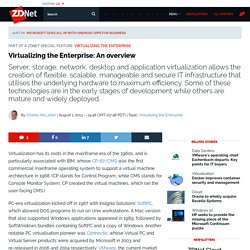
(CP stands for Control Program, while CMS stands for Console Monitor System; CP created the virtual machines, which ran the user-facing CMS.) PC-era virtualization kicked off in 1987 with Insignia Solutions' SoftPC, which allowed DOS programs to run on Unix workstations. A Mac version that also supported Windows applications appeared in 1989, followed by SoftWindows bundles containing SoftPC and a copy of Windows. Another notable PC virtualisation pioneer was Connectix, whose Virtual PC and Virtual Server products were acquired by Microsoft in 2003 and re-released in 2006 and 2004 respectively.
Virtualization Technology & Virtual Machine Software. Virtual Machine Technology. The key component in building this abstraction layer is commonly referred to as a VMM (virtual machine monitor) or, sometimes, a hypervisor.
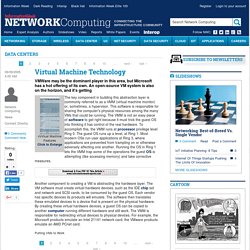
This software is responsible for sharing the computer's physical resources among the many VMs that could be running. The VMM is not an easy piece of software to get right because it must trick the guest OS into thinking it has control of the real hardware. To accomplish this, the VMM runs at processor privilege level Ring 0. The guest OS runs up a level, at Ring 1. Most modern OSs run user applications at Ring 3, where applications are prevented from trampling on or otherwise adversely affecting one another. Another component to creating a VM is abstracting the hardware layer. Putting VMs to Work. Introduction to Virtualization. VMware ESXi virtual machine maximums. Nextware Technologies Blog - Archive - VSP. VMware Virtualization Overview In the mid-1960s.
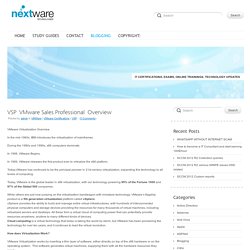
IBM introduces the virtualization of mainframes. During the 1980s and 1990s, x86 computers dominate. In 1998, VMware Begins. In 1999, VMware releases the first product ever to virtualize the x86 platform. Today,VMware has continued to be the principal pioneer in 21st century virtualization, expanding this technology to all levels of computing. Today, VMware is the global leader in x86 virtualization, with our technology powering 99% of the Fortune 1000 and 97% of the Global 500 companies.
While others are just now jumping on the virtualization bandwagon with immature technology, VMware’s flagship product is a 5th generation virtualization platform called vSphere. vSphere provides the ability to build and manage entire virtual infrastructures, with hundreds of interconnected physical computers and storage devices providing the resources for many thousands of virtual machines, including virtualized servers and desktops.
Quiz: VMware Virtualization Fundamentals – VMware Server and VMware ESXi. By Ramesh Natarajan on June 2, 2010 We are starting a new series of articles on VMware that will help you install, configure and maintain VMware environments.
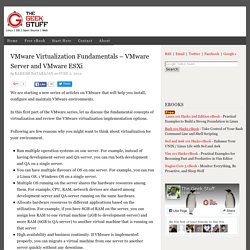
In this first part of the VMware series, let us discuss the fundamental concepts of virtualization and review the VMware virtualization implementation options. Following are few reasons why you might want to think about virtualization for your environment. Run multiple operation systems on one server. For example, instead of having development-server and QA-server, you can run both development and QA on a single server.You can have multiple flavours of OS on one server. Difference between vSphere, ESXi and vCenter. There is a lot of buzz of VMware virtualization solution these days.

No doubt that VMware is the number one virtualization solution provider in the industry. People who are new to VMware’s virtualization platform often get confused while learning VMware vSphere and its components. So today I will be explaining all about vSphere and its components. Folks face difficulty to know about major components of vSphere. How to Add a VMware vCenter Server to VMM. Applies To: System Center 2012 SP1 - Virtual Machine Manager, System Center 2012 R2 Virtual Machine Manager, System Center 2012 - Virtual Machine Manager You can use the following procedure to add a VMware vCenter Server to Virtual Machine Manager (VMM).
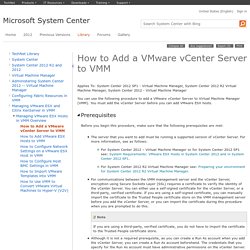
You must add the vCenter Server before you can add VMware ESX hosts. Before you begin this procedure, make sure that the following prerequisites are met: The server that you want to add must be running a supported version of vCenter Server. For more information, see as follows:For communications between the VMM management server and the vCenter Server, encryption using Secure Sockets Layer (SSL) requires a certificate to verify the identity of the vCenter Server. What is VMware VCenter Server? - Definition from Techopedia. VCenter Server is installed at the primary server of a virtualized data center and operates as the virtualization or virtual machine manager for that environment.

It also provides data center administrators and a central management console to manage all the system's virtual machines. Virtual center provides statistical information about the resource use of each virtual machine and provisions the ability to scale and adjust the compute, memory, storage and other resource management functions from a central application. WP VM vSphere 6.0 GameChanger uk. VMware vCenter Design and Installation Options. There have always been questions around why, how, and where VMware’s vCenter should be installed and what design option is best.
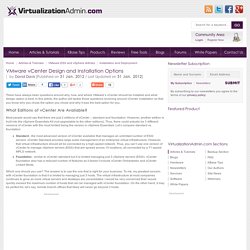
In this article, the author will tackle those questions revolving around vCenter installation so that you know why you chose the option you chose and why it was the best option for you. What Editions of vCenter Are Available? Most people would say that there are just 2 editions of vCenter – standard and foundation. However, another edition is built into the vSphere Essentials Kit (not upgradable to the other editions). Thus, there could actually be 3 different versions of vCenter with the most limited being the version in vSphere Essentials. What is the difference between VMware ESX, ESXi, vSphere and vCenter? – Stackzilla. It is quite easy to confuse the VMware products ESX, ESXi, vSphere and vCenter.

The purpose of this article is to demistify the whole thing. But first a little background. Virtualization technology allows multiple servers to be installed on the same physical machine. In just the last five years server hardware capability has increased so much that you can virtualize just about any server on the market today. This has enabled organizations to do a lot more with fewer resources. For those new to VMware a brief explanation of VMware’s core offerings can help to minimize confusion. ESX and ESXi are the hypervisors that most commonly sit right one on bare metal. ESXi has a tiny footprint when installed and takes up as little as a few hundred MBs on a drive when fully installed.
ESXi is a fairly uncomplicated to install and configure. What is VMware vCenter Server? VMware vCenter Server, formerly known as VirtualCenter, is the centralized management tool for the vSphere suite....
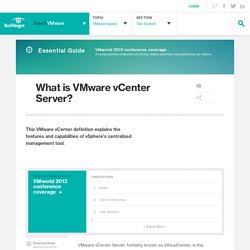
By submitting your email address, you agree to receive emails regarding relevant topic offers from TechTarget and its partners. You can withdraw your consent at any time. Contact TechTarget at 275 Grove Street, Newton, MA. vCenter Server: physical or virtual? - vInfrastructure Blog. This post is also available in: Italian. VMware vCenter Server Virtual Appliance (vCSA) features and benefits. The VMware vCenter Server Virtual Appliance (vCSA) provides an alternative option for organizations that chose not to run the Windows vCenter Server but still require centralised management of VMware vSphere deployments in the enterprise. It provides exactly the same functionality as the traditional Windows vCenter Server but packaged in a Linux distribution. I know that some of my pure UNIX and LINUX customers have been asking for this for a while. It’s been available as a technology preview since 2009 as “vCenter 2.5 on Linux” but has finally arrived with vSphere 5 to give customers’ an alternative to the Windows vCenter Server.
Assignment1.